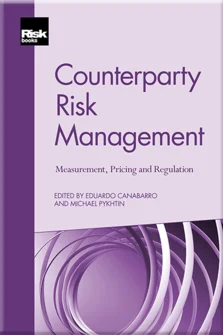Central Counterparty Risk
Matthias Arnsdorf
Central Counterparty Risk
The Basel III Enhancements to Counterparty Risk Capital Charges
The Regulation of Counterparty Risk in Over-the-Counter Derivatives Markets
The Non-Internal Model Method for Counterparty Credit Risk
On Credit Valuation Adjustments and Regulatory Capital
American Monte Carlo: A Practitioner Approach
Best Market Practice for Calculation and Reporting of Wrong-Way Risk
Central Counterparty Risk
CVA Risk Management Post-Crisis
Re-Thinking CVA: Valuations, Counterparty Credit Risk and Model Risk
Should Derivatives Dealers Make A Funding Value Adjustment?
Adjoint Algorithmic Differentiation: Real-Time Counterparty Credit Risk Management in Monte Carlo Simulations
Stress Test of Counterparty Risks and Dynamic Hedging of the CVA
Dynamic Stress Testing of Counterparty Default Risk
Collateral: Modelling, Pricing and Optimisation

Central counterparties (CCPs) are a key part of the financial system. Their systemic importance is likely to increase further with time as they are viewed as a key mitigant of credit risk and contagion while providing increased transparency to the derivatives market. It is thus critical that the risks of membership to a CCP are well understood and quantified.
Central counterparties are designed to mitigate counterparty risk by holding high levels of collateral and via loss mutualisation. This transforms a large part of the credit risk inherent in bilateral transactions into liquidity risk. However, it also leaves the clearing members exposed to concentrated tail risk. A clearing member of a CCP is exposed to losses on their default fund and potentially on their initial margin contributions. Such losses can be incurred whenever the CCP has insufficient funds to unwind the portfolio of a defaulting clearing member. This does not necessarily require the default of the CCP itself. This risk is explicitly recognised in the Basel III rules that require the capitalisation of default fund exposures.
In this chapter we shall look at how to understand and quantify the risks a bank has
Copyright Infopro Digital Limited. All rights reserved.
As outlined in our terms and conditions, https://www.infopro-digital.com/terms-and-conditions/subscriptions/ (point 2.4), printing is limited to a single copy.
If you would like to purchase additional rights please email info@risk.net
Copyright Infopro Digital Limited. All rights reserved.
You may share this content using our article tools. As outlined in our terms and conditions, https://www.infopro-digital.com/terms-and-conditions/subscriptions/ (clause 2.4), an Authorised User may only make one copy of the materials for their own personal use. You must also comply with the restrictions in clause 2.5.
If you would like to purchase additional rights please email info@risk.net











